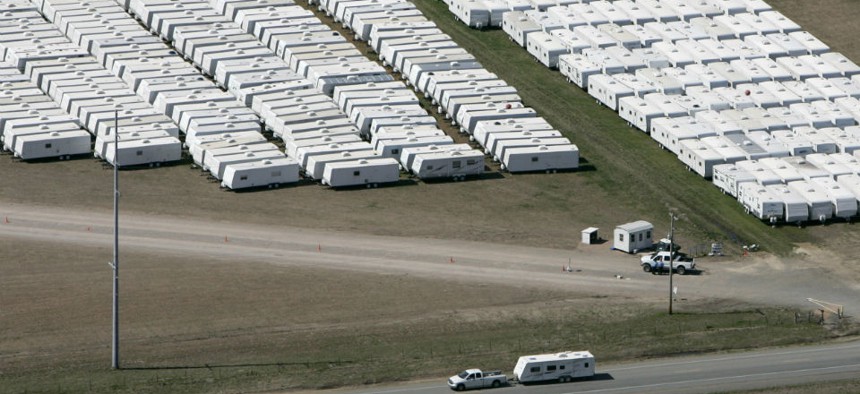
FEMA trailers used to house victims of past disasters. Danny Johnston/AP file photo
FEMA Spent Billions on Disaster Assistance Overhead During the Last Decade
The agency allocated nearly $13 billion for expenses related to compensation, travel and supplies for disaster relief personnel from fiscal years 2004 to 2013.
The Federal Emergency Management Agency spent nearly $13 billion during the last decade on administrative costs related to major disaster assistance, on average more than double what it spent in the 1990s.
The amount FEMA devoted to overhead expenses -- including compensation and travel costs for disaster relief workers, rent and security costs for field operations, and supplies -- was 13 percent of the overall $95.2 billion allocated from the disaster relief fund for the 650 major disasters declared from fiscal years 2004 to 2013. That’s too much, according to the Government Accountability Office.
“FEMA’s administrative cost percentages have risen for major disasters of all sizes, and FEMA has not implemented our 2012 recommendation to implement goals for administrative cost percentages and monitor performance to achieve these goals,” concluded a December 2014 GAO report.
The number of major disaster declarations has increased significantly in the past few decades, so more money overall is being spent on helping communities and individuals recover and rebuild. Presidents declared 32 percent more major disasters between fiscal years 2004 and 2013 than in the preceding 10 fiscal years.
FEMA’s $95 billion disaster relief fund for fiscal 2004 to fiscal 2013 allocated 48 percent ($45.3 billion) to public assistance; 27 percent ($25.9 billion) to individual assistance; 13 percent ($12.7 billion) to overhead; 6 percent ($6.1 billion) to mission assignment; and 5 percent ($5.2 billion) to hazard mitigation. Due to rounding, that adds up to 99 percent, rather than 100 percent.
Of the $12.7 billion the agency spent on administrative expenses over the 10-year period GAO reviewed, $5.4 billion, or 43 percent, went to overhead expenses for Hurricane Katrina. In addition to allocating money for salaries and benefits as well as IT and other equipment for disaster relief workers, FEMA also reimburses certain overhead costs for state, local and tribal governments recovering from major disasters. That totaled $1.7 billion over the time period studied, which was included in the public assistance portion of the disaster relief fund. A 2007 change in the policy related to reimbursing those admin costs to states and localities “led to an unexpectedly high rate of claims for direct administrative costs” and “increased administrative complexity and workload,” FEMA officials told GAO.
This is not the first time GAO has criticized FEMA for getting a handle on growing administrative costs related to disaster relief – the watchdog issued a similar report in 2012. FEMA issued guidance in November 2010 aimed at better controlling overheard expenses. “However, FEMA did not require that this guidance be followed or targets be met because the agency’s intent was to ensure flexibility and provide general guidance rather than to stipulate a prescriptive policy or formula,” GAO said in its latest report.
In July 2014, FEMA released its four-year strategic plan, which includes a goal to reduce its average annual percentage of administrative costs by 5 percent by the end of 2018. Officials also have tried to rein in the amount of overtime disaster assistance personnel work. Since 2011, FEMA has decreased the average overtime per person “from almost 16 hours per pay period to 7.5 hours per pay period,” said the report. Since April 2013, FEMA has reduced its monthly telecommunications costs by more than $1 million per month, according to the study.
“However, despite FEMA’s efforts since November 2010, FEMA’s average administrative cost percentages have not significantly decreased,” GAO concluded.
The watchdog recommended that FEMA develop a comprehensive plan to better control administrative costs associated with major disasters, including targets for accomplishing goals, and making senior officials accountable for monitoring and measuring performance. GAO also suggested FEMA assess the costs versus the benefits of how FEMA tracks overhead expenses for major disasters as well as clarify its guidance and requirements for claims submitted by grantees.
FEMA agreed with all the recommendations and plans to complete them by fall 2015.







